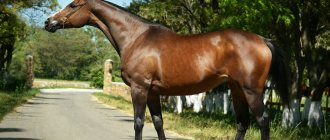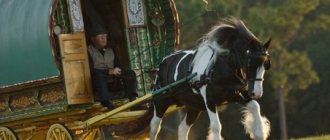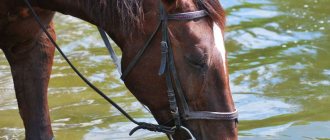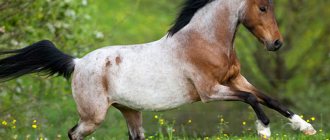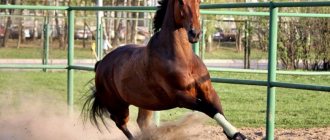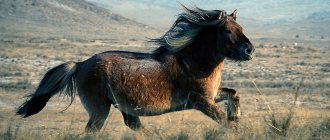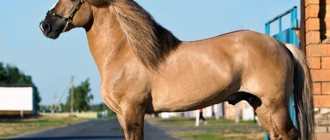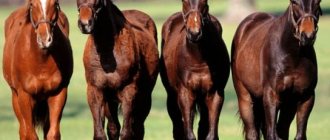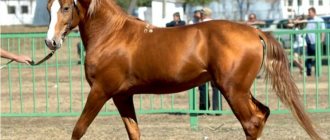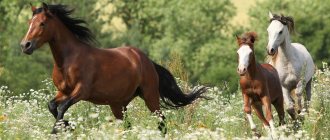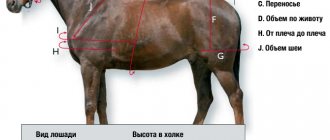Arabian horses are an ancient breed that was bred in the 4th-7th centuries AD. on the territory of the Arabian Peninsula. Arabian riding horses took part in the creation of many other breeds - English Saddlebred, Oryol Trotter, Barbary, Russian Saddlebred, Lusitano, Andalusian, Percheron, Lipizzan, etc. Due to their high endurance, Arabians regularly take part in long horse races that last 5-6 days, and on each day it is necessary to cover a distance of up to 100 miles.
Main characteristics of the breed
Color: gray, red, black and bay.
Height at the withers: from 1.47 to 1.55 m. On average, for mares - 1.506 m, for stallions - 1.534 m.
Exterior: small head, concave profile, small ears and wide nostrils. Graceful neck, long slanted shoulders, beautifully defined withers. Smooth short back, wide chest. Solid legs with clearly defined tendons. Tail set high, soft and silky.
Use: mostly in horse riding and racing. For amateur horse riding. In addition, Arabian horses are still used in crossbreeding, improving many other breeds. In addition, breeding work is carried out within the breed, aimed at developing and preserving the best qualities of Arabs, as well as increasing their growth.
Features: Arabian horses are distinguished by enviable endurance - with a height of no more than 1.53 m at the withers, they can easily carry adult riders. In addition, Arabian horses regularly take part in horse racing, the last stage of which involves covering a distance of 161 km (100 miles) in 1 day. They are distinguished by longevity and good health.
Bay Arbian horse
Origin story
Photo of the breed:
In the formation of the breed, a major role was played by the constant wars of the Bedouin Arabs, who used these horses as military horses.
As a result of such specific selection with excellent care and feeding in desert and semi-desert conditions, a medium-sized, tightly built, thoroughbred horse appeared, very hardy and playful at a gallop, with excellent movements at all gaits.
For a long time, Arabian horses were the most valuable wealth of local nomads. They were prohibited from sale to other lands, including Europe, under penalty of death.
Crossing Arabian horses with other breeds was prohibited, so the breed has been developing in purity for many centuries.
The first Arabian horses appeared in Europe during the Crusades.
Despite their small stature (in those days, Arabian horses were somewhat smaller than modern ones), these horses were so playful and beautiful that they immediately became improvers of many European horse breeds - riding, draft and draft horses.
The breed has played a huge role in the world horse breeding. Using it the following were created:
- Thoroughbred (Great Britain);
- Barbary (Morocco);
- Andalusian (Spain);
- Lusitano (Portugal);
- Lipizzan (Austria);
- Szagiya (Hungary);
- Oryol trotter;
- Orlovo-Rostopchinskaya;
- Streltsy (and on its basis - Terek) (Russia);
- also heavy draft breeds - Percheron and Boulogne (France).
The Arabian is one of the oldest human-created horse breeds in the world.
It is believed that its ancestor was the local horse of the Arabian Peninsula, which was distinguished by its lightness and endurance. The first images of such horses, found in caves on the Arabian Peninsula, date back to the 2nd millennium BC.
Horses with thin heads and high tails are found in works of art of Ancient Egypt as early as the 16th century BC.
Some researchers of the Arabian horse breed suggested that it originated from the equus caballus pumpelli, a separate subspecies of horse.
However, most scientists are confident that the “dry” eastern desert horses, the ancestors of the modern Arabian horse, descended from Equus ferus caballus, and the breed’s characteristic exterior features were formed under the influence of the environment.
Recent genetic studies of mitochondrial DNA in Arabian horses of Polish and American origin suggest that the modern breed has a heterogeneous origin with ten haplogroups.
The modern concept of breed purity in the modern population has not been traced beyond 200 years.
There are different opinions about where the ancestors of modern Arabian horses originally lived. Most researchers assume that the "proto-Arab" came from the area along the northern edge of the Fertile Crescent.
This theory is supported by the fact that ancient household items depicting horses were discovered on the territory of the Fertile Crescent, while on the Arabian Peninsula they date back no earlier than 1800-2000 BC.
Other scientists believe that the homeland of the Arabian horse is the southwestern corner of the Arabian Peninsula in the territory of modern Yemen, where at that time there were good natural pastures.
This hypothesis received renewed attention following the discovery in 2010 of horse artefacts at Al Maghar in southwestern Saudi Arabia, dating to between 6590 and 7250 BC.
Arabian horse in “native costume”, used both at the exhibition and at the competition
But ultimately, it was the climate and the nomadic culture of the Bedouins that created the Arabian horse. Desert horses were required to have endurance and unpretentiousness, the ability to withstand the conditions of arid deserts with extreme daily temperature changes.
During military campaigns, where there was no pasture or water, the Bedouins fed their horses dates and camel milk.
The Bedouins depended on camels and horses for their livelihood. The Arabian horse was raised as a fighting comrade - playful, hardy, intelligent.
Since many raids required secrecy, mares were used in military operations, since they were calmer, quieter and did not give away the positions of the fighters with their neighing.
To avoid horse theft and protect them from predators and bad weather, the Bedouins allowed the most valuable animals into their tents at night.
Origin of types
For centuries, the Bedouins have traced the origins of each horse through oral tradition.
Horses of the purest blood were known as Asil, and crossing with non-Asil horses was prohibited.
Mares were the most valuable for both riding and breeding, and the pedigrees of all horses were traced through the female line.
The Bedouins did not believe in geldings, and stallions were considered too difficult to train to be good war horses.
Therefore, very high selection requirements were placed on stallions.
Purity of bloodline was very important for the Bedouins. They believed in telegony, believing that if a mare ever mated with a stallion of "impure" blood, then the mare herself and all future offspring would be "contaminated" by the stallion.
Over time, several types have developed in the breed, each of which has unique features and can be traced through the maternal line.
According to the American Arabian Horse Breeders Association, the breed originally had five types: Keheilan, Seglawi, Abeyan, Hamdani and Hadban.
Propagandist and writer Karl Raswan, who has specialized in Arabian horses since the mid-20th century, believed that there were only three types: Kehilan, Seghlavi and Muniki.
However, modern studies of mitochondrial DNA suggest that modern Arabian horses, descended from mares of the same intrabreed type, may in fact not have common maternal ancestors.
The first written pedigrees in the Middle East to use the term "Arabian horse" date back to 1330 AD.
Akhal-Teke breed: Akhal-Teke
The breed received its modern name from the name of the Ahal oasis, located at the northern foot of Kopet-Dag, which was inhabited by the Turkmen tribe Teke (or Tekins). This is one of the oldest breeds in the world, which had a significant influence on such breeds as Arabian, thoroughbred, etc.
Unfortunately, the generalized name among Europeans for all eastern horses, “Arabian horse,” does not make it possible to reliably establish the extent to which Turkmen horses were used in the creation of European breeds. Although according to official documents the breed can only be traced back to 1885, the history of the Akhal-Teke goes back more than one millennium.
The life of the Turkmens was spent in campaigns, raids and skirmishes. With this way of life, the quality of horses was one of the most important issues for them. Nomads could not keep herds of horses for grazing, since in the hot desert climate the vegetation that appeared in early spring burned out by the beginning of summer. The fodder was grown on irrigated lands.
Therefore, the horses were kept one at a time on a leash near the yurt and fed by hand. The food, albeit in small quantities, is the best and high-calorie: dried alfalfa, selected barley, flatbreads greased with lamb fat, camel milk.
At first glance it may seem that the treatment of horses was cruel, but this is not so. The horses were cared for like children, they were carefully looked after from the first days, and everything was given to the horses. The foals were raised as family members, surrounded with attention and love - it’s not for nothing that Akhal-Teke horses are considered horses of one owner and are distinguished by their loyalty.
The harsh conditions of detention contributed to the fact that over centuries the horses of the Akhal-Teke breed developed unique features of constitution and adaptability to work under the scorching rays of the sun. The horses became lean and dry, without excess fat, unusually hardy and not demanding in terms of quantity (but not quality) of food. Exceptional endurance and the ability to quickly recover strength after work are very valuable qualities inherent in these horses. They can withstand hunger, thirst and heat, as well as serious temperature changes better than all other breeds.
These horses, with their smooth, trailing movements, are very good to ride, but require special handling, which is why some athletes find them difficult to work with.
Anyone who has seen an Akhal-Teke horse will always be able to distinguish it from other horses: its exterior is very unusual and amazes with its sophistication and grace. His shape resembles a greyhound dog - tall, dry and lean. This is the body type of a sprinter. However, the outwardly fragile Akhal-Teke horses are very hardy - in 1935. A horse race was held from Ashgabat to Moscow, where the Akhal-Teke horses showed their endurance and strength, covering 4,300 km in 84 days, while they crossed the waterless Karakum (360 km) in three days.
The head of Akhal-Teke horses is medium-sized, dry, light, with a straight or slightly hook-nosed profile and large, expressive, deep-set eyes, slightly slanted. The deer neck is thin and long with a high output. Long back, sometimes slightly sagging, with a strong croup. The chest is narrow, but relatively deep. Straight, dry legs. The skin is very thin, the mane and tail are sparse, sometimes the mane is almost completely absent.
The breed's colors are varied: black, gray, bay, red, dun, nightingale, and the rare Isabella. Almost all Akhal-Teke dogs have a golden hue to their coat, which transforms their color.
In 1928, gray horses in the breed comprised more than 36%, followed by bay (about 21%), then came: black (14%), red (13.7%), dun (10.6%), nightingale (together with isabella 2.2%). Now this ratio has changed: the bay color is in first place (40%), the second is dun (more than 20%), followed by black (12%), red (11%), gray (8%), nightingale (5%) and isabella (2.5%).
Description
Appearance
Photo:
The horses of this particular parade are incredibly beautiful. They are considered the standard of beauty and grace. In their historical homeland there was a belief that they were created by the wind.
Arabian majestic horses are distinguished by their short stature and stocky body type. Individuals of this breed exhibit pronounced sexual dimorphism. Males are slightly larger and have more body mass than females.
Main characteristics of the breed:
- height at the withers for males is 150-160 centimeters, for females – 140-150;
- body weight is 450 – 650 kilograms depending on gender and age;
- long, slender limbs;
- long, graceful and very graceful neck line, which is often called the “swan”;
- aristocratic, small head shape.
It is noteworthy that the tail of these horses is always slightly raised up, and while running it practically stands straight up and flutters very beautifully in the wind.
Expressive, large eyes clearly stand out on the small head. The cheek line is clearly defined. The shape of the head is very graceful, the forehead has a square shape. The ears are small, pointed upward, and very mobile.
Interesting fact: If you look at the animal in profile, the concave area of the bridge of the nose is clearly visible. This form is typical only for Arabian horses.
The color of Arabian horses comes in three varieties: white, bay and black. Young foals are always light in color. As they grow older, the color darkens and darker, more saturated colors appear. The animals' mane is long, soft and very pleasant to the touch.
Interesting fact: Another distinctive feature is the specific structure of the skeleton. They have only 17 ribs, 5 lumbar and 16 caudal vertebrae. Representatives of other breeds have 18 ribs, 6 lumbar and 18 caudal vertebrae.
Horses of medium size have a back and a wide chest with a muscular, well-developed shoulder girdle. Now you know what an Arabian horse looks like. Let's see what this horse eats.
Character and lifestyle
Beautiful appearance is not the only advantage of Arabian horses; they also have a well-developed intelligence. Animals are capable of quickly perceiving information, learn quite easily, and have good memory.
Therefore, if you offend a horse, it will remember it for a long time and is unlikely to ever be able to forgive its offender.
Due to its strong character, the animal feels strong-spirited people and obeys mainly only them. For this reason, this breed is rarely suitable for riding.
Arabian horses are friendly towards their owner, so the animal will be devoted to him. These noble horses have a very stubborn character; it is almost impossible to force them to do anything.
If a trusting relationship arises between the owner and the animal, the latter, in turn, will make every effort to please the former.
The Arabian horse breed is distinguished by its good health. They can withstand bad weather well, are incredibly hardy, and running long distances is not a huge problem for them.
Arabian horses are often used in sports competitions. Such races are held regularly and are an excellent test of the endurance of animals. This breed of horse is not considered one of the fastest, but their agility remains until the very finish.
Interestingly, representatives of the Arabian horse breed are excellent at acting and dancing.
Character
The character of the Arabian horse, despite its agility, is very calm and pliable. Horses lived next to humans for a century; the Bedouins kept them in their tents with the whole family, gave them milk and fed them better than they ate themselves. Therefore, Arabs are strongly attached to their masters. They say that this is the kindest and most loyal breed. In addition, this breed of horses has excellent hearing, the horses are excellent at oriented in space and always find their way home.
Intelligence indicators are very high, stallions and mares are perfectly trainable. They are not only smart, but also submissive. They will obey the owner in any manner, although they respond best to affection and encouragement. Eastern horses participate in competitions that require good obedience and high intellectual abilities: show jumping, dressage, hurdles, etc.
In addition, modern Arabian purebred horses are distinguished by incredible endurance. They are able to ride 160 km per day and repeat this record for 6-7 days in a row. This breed has no equal in racing. Despite his relatively small stature, the stallion calmly carries an adult rider on his back. In terms of speed, these horses are now inferior to some modern breeds, for example, thoroughbred horses. But their qualities are more balanced; they can maintain physical fitness and activity over long distances.
The Arabian mare is very fertile; females are able to give birth to foals until old age. The lifespan of horses is about 30 years, they are record holders among all thoroughbred horses. They are in good health and rarely get sick. Even not the best living conditions and poor treatment do not affect the well-being of horses.
Kinds
The Arabian horse breed consists of several horse families, the most popular of which are Kohlani and Atesh.
By the way, they are the most ancient representatives of the breed, so in many characteristics they are significantly superior to other families.
Central Arabia is considered the birthplace of nedzheli. These horses are incredibly noble.
In the modern world there are 5 types of Arabian horses.
Hadban
The racehorse of this species is considered the largest representative of the Arabian breed. She is quite playful and hardy, so she is often used in horse racing. Horses with a red or bay coat are often found. It is a little less common to see gray animals.
Siglavi
A characteristic feature of such horses is their light build. These animals are small in stature. Mostly horses are gray in color.
Interestingly, gray horses have black skin around their eyes and snoring area. Since childhood, the Siglawi foal has been preparing for performances at various shows and exhibitions.
Koheilan
These animals are distinguished by their incredible endurance. The physique is very strong and massive. This type of Arabian horse breed is also very often used in racing.
Koheilan-siglawi (Obeyan)
This horse is a hybrid obtained from representatives of the Siglavi and Koheilan. Outwardly, these animals look very attractive and also have a strong physique.
Obeian are quite tall. The most popular colors among representatives of this breed are red, bay and gray.
Maanegi
Representatives of this type of Arabian horse have long legs and a narrow chest. They travel great distances well. The height of such horses can reach 1.6 meters.
Usage
The main focus of the Arabian horse breed is participation in various competitions. These are exhibitions and shows, smooth racing at hippodromes, distance runs. Animals can jump from the age of 3 years, and at two years old they begin testing on hippodromes. Three times the Soviet “Arabs” won the “European Prize”.
Today, in many Russian hippodromes you can watch races on oriental horses. The All-Russian Derby takes place at the Pyatigorsk Hippodrome. The best representatives of the “Arabs” are now bred in the Tersky, Pyatigorsk and Moscow stud farms. They are also kept on private farms.
“Arabs” are good at amateur riding and non-professional equestrian sports. They are also used for introductory crossbreeding in horse breeding to improve other sport horses. And selection work is carried out to preserve and improve the qualities of the breed, and to increase growth.
To evaluate the speed of the horses, we will give exact figures: they run a distance of a kilometer in just a minute and 8 seconds, 50 km in an hour and 38 minutes. Individuals of both sexes cover 100 km in 6 hours. The Arabs show good speed and endurance even at distances of 160 km.
Content
It is recommended to create favorable conditions for keeping animals of this breed. It is best to keep these horses in a herd, as this method is considered economical. Herd keeping contributes to the formation of the character of animals.
They become hardy and hardened. In addition, in this way you can breed Arabian horses much faster. Such horses can also be kept individually.
Usually this method is used in relation to sports horses, young animals or breeding males.
In the case of mares, the following can be individually kept:
- young animals;
- single horses;
- suckling mares.
With any method of keeping Arabian horses, they should be provided with the necessary care.
Nutrition
Considering that the homeland of Arabian horses is characterized by a hot and arid climate and sparse vegetation, they are very unpretentious and not selective in their choice of food.
In ancient times, breeders of Arabian horses used pasture as the main source of food, which was not always of good quality.
They were also given hay and cereals, as well as camel milk. It often served as a source of liquid and replaced drinking.
Interesting fact: Arabian horses are the only horses in the world whose bodies metabolize fats of animal origin.
The food supply of modern horses is many times richer and more varied.
The basis of the diet is high-quality hay and grass. The diet also includes grains, vegetables, and vitamin supplements.
Horses that are used as labor must include at least 6.5 kg of oats daily in their diet, as well as fresh vegetables and quail eggs.
The Arabian horse's daily menu is as follows:
- 4.5-5.5 kilograms of selected, high-quality oats;
- 5-0.7 kilograms of high-quality, selected straw;
- 4-5 kilograms of alfalfa hay;
- approximately 1.5 kilograms of bran;
- up to a kilogram of boiled flax seed;
- vegetables fruits.
The animals are in excellent health. To preserve and maintain it, it is recommended to include vitamin and mineral supplements in your diet daily.
It is recommended to distribute the daily diet so that the main amount of food is consumed in the evening. It is better to take animals out to water early in the morning.
Drink
Arabian horses must receive the required daily fluid intake per day. Water is given to animals up to 5 times a day before meals.
The average amount of water per day is 50 liters, in winter it is reduced to 30. The water must be clean, the normal temperature is 10-15 degrees.
After training, fluids should not be given to the horse for half an hour.
Stable
A lot of effort needs to be put into arranging the stables, since the horse spends most of his time here.
The room in which the horses will be kept must be large and spacious, with normal air humidity. The stable should also be very clean and warm.
Stages of construction and arrangement of premises for horses.
- Choosing a location . It is best to build a stable on an elevated area. There should be no highway or various bodies of water nearby. It is also not recommended to build a stable near a populated area, as animals love silence. The absence of ponds will help keep the room dry during the rainy season.
- Foundation . For the foundation of the room you need to use reliable material. It is necessary to provide it with normal moisture insulation, for example, using roofing felt.
- Building materials . The material for the construction of the stable must have heat-resistant and waterproof properties.
- Floor . The covering in the room should be warm and strong. The stall usually uses an adobe floor. It is recommended to lay a wooden covering in the passage. Sometimes they resort to using concrete.
- Heat-resistant bedding . To keep the floor in the stable warm, a large layer of straw or sawdust is placed on it.
- Roof . The structure must be solid and highly durable. Ordinary slate is perfect. Metallic coating is also often used. The ceiling height must be at least 3 meters. For insulation, the roof is filled with straw and sand. The ceiling should consist strictly of solid wood material.
- Ventilation . Typically, such rooms have a supply and exhaust ventilation system.
- Lighting . It is advisable to place windows at a level of two meters from the floor. This is done so that the scorching sun does not blind the animals. Sometimes they resort to installing artificial lighting.
- Feeders . The depth of the container must be at least 30 centimeters; it is usually located at a level of one meter from the floor.
- Corral . Not far from the stables you need to make a corral for horses. One animal needs 20 square meters.
It is imperative to equip a room for storing animal feed. We should not forget that it is necessary to keep the horses clean, so it is necessary to create a room for washing them. It is also necessary to equip a staff room and a warehouse for equipment.
Grazing
Arabian horses need frequent walking. Typically, they should be taken for a walk at least twice a day. To do this you need to find suitable pasture.
They are also often walked in paddocks. During the cold season, the duration of animal walks is reduced.
This is because Arabian horses do not like low temperatures. During the cold season, the time allocated for training animals is also reduced.
Cleaning
Horses must be cleaned regularly. You need to wash the animal very carefully, otherwise you can harm it.
Use the necessary equipment for this procedure:
- scraper;
- brush;
- comb;
- crest;
- velvet cloth;
- hoof hook;
- several sponges;
- vacuum cleaner.
Horseshoes
Horseshoes protect the horse’s hooves from all kinds of damage and also look aesthetically pleasing.
Types of horse shoeing.
- Universal . Suitable for all representatives of the breed.
- Special . Used for horses participating in racing.
- Orthopedic . This type of shoeing is used in case of an animal injury.
- Studded . Excellent for traveling on ice, so it is installed in winter.
Cleaning
Daily brushing of the horse ensures that it looks well-groomed, has shiny hair and a healthy condition.
It is important to know how to properly wash an Arabian horse so as not to harm the delicate skin.
Step-by-step instructions for cleaning a horse
Prepare the necessary equipment:
- whalebone brush;
- hair brush;
- rubber scraper;
- plastic or rubber scraper;
- separate sponges for the face and under the tail;
- velvet cloth;
- wooden comb;
- hoof hook;
- vacuum cleaner.
Prices for WAHL horse cleaning brushes
Brushes for cleaning horses from dirt WAHL
Step Photo Description 1
Start cleaning from the neck, moving to the back, sides, and stomach. Wash your feet and hooves last. 2
Run the hair brush against the growth of the horse's hair, followed by the same place along the growth. 3
Using a soft comb, go over the horse's body, removing dust, dirt, and sweat. 4
Wash your croup, neck, legs with a damp washcloth.
Follow with a dry cloth. 5
Using a sponge, thoroughly but gently clean your face, paying attention to the nostrils, ears, and eyes. Pat your face dry. 6
Wash your mane, bangs and tail with a special shampoo.
Use a comb to comb your hair. The tail requires separate hygiene items. 7
Using a hook with a blunt end, clear the hooves of stones, sand, and vegetation. 8
Use a vacuum cleaner with different attachments for each part of the body to dry your horse. 9
Give the horse a walk for 20-30 minutes if the weather is warm and sunny.
Breeding
Experts have been breeding Arabian horses for many centuries.
At the same time, they manage to preserve the unique characteristics of the animals and make many improvements to this variety. In Russia, the Terek stud is famous for having the best Arabian horses in the country.
They gained fame thanks to their successful performances in various shows and sports competitions.
In Arab countries and Europe they are also actively breeding this breed of horses. In the UAE, such horses belong to noble people, including the royal family.
Local stables are considered the best in the world; they have everything for keeping animals.
The activities of breeders cover several areas of activity.
Selection work is carried out for the following purposes:
- breeding production;
- the creation of new breeds;
- improvement of the breed;
- horse racing and sports;
- creation of a new line.
Only high-breed horses should be involved in the breeding process. In addition, they must be mentally stable, have excellent conformation and have a good pedigree. In this case, only purebred horses can be crossed.
Pregnant mares are always kept separately from the main herd. They are intended for reproduction. A horse can bear its offspring for about 11 months.
Throughout pregnancy, it is necessary to carefully monitor the mare's diet. It is advisable to adhere to a strict diet for the last three months.
Food must contain the required amount of nutrients, among them are:
- phosphorus;
- calcium;
- protein;
- vitamins.
When a horse begins to look for a secluded place, this means a quick foal. Basically, the birth process occurs in the evening or at night.
The mare is able to give birth to foals on her own and requires virtually no human assistance. After three hours, the female's privacy can be disturbed.
Health
It is known that Arabian horses have a good immune system, but these animals are still susceptible to diseases.
The most important thing is to study all the nuances of treatment and prevention of diseases of Arabian horses.
It is also necessary to show the animal to a veterinarian from time to time. We bring to your attention the most common diseases of Arabian horses and the prevention of their treatment.
Stomach colic
As you know, the gastrointestinal system of horses is very sensitive, so if the diet is disrupted or there is an insufficient amount of useful elements, health problems can begin.
Prevention:
- Gradually start giving your horses large feeds;
- monitor the quality of products;
- do not soak food in water;
- fill your daily diet with foods that contain fiber;
- use food from different manufacturers, combine them with already familiar products.
Laminitis
This disease is quite common among representatives of the Arabian horse breed. It is characterized by damage to the top layer of skin that is located under the hoof.
Laminitis can be recognized by several signs:
- high temperature of the extremities;
- when walking, the horse takes small, quick steps;
- partial refusal to move.
The causes of laminitis are excessive feeding and a lot of time spent on hard surfaces.
At the first symptoms of the disease, it is recommended to consult a veterinarian.
Before the doctor arrives, it is necessary to provide first aid to the animal:
- It is better to place the horse on a hard surface;
- remove all food and flooring nearby;
- put water in front of the animal;
- wash the hooves;
- treat with a special antihistamine-based product.
An Arabian horse must be vaccinated against:
- anthrax;
- rabies;
- flu;
- tetanus;
- rhinopneumonia.
Once every six months it is recommended to donate the animal’s blood to:
- leptospirosis;
- glanders;
- infectious anemia;
- sat down.
By adhering to these simple rules of prevention, you can avoid many diseases in Arabian horses.
How much does an Arabian horse cost?
The value of Arabian horses lies not only in their moral principles and qualities, but also in monetary terms. And basically, establishing and fixing the cost of a horse depends on its pedigree, the qualities of the parents and the acquired skills of the young horse. The minimum request for a young Arabian horse is 4 thousand euros, the highest price to date is several million American dollars.
The most expensive Arabian horse, Padron, was officially listed in historical notes, costing its new owners $11 million. And in 1995, at the next American auction, the champion of the race called Pesnya, Pesnyar was sold. The young and already successful Pesnyar was given away for $1 million, colossal money at that time. In 1977, a race called Metropolis took place, the winner of which was an Arabian horse named Menes. Due to its popularity, the young horse was given to the arena for a period of 15 years, for which its temporary owners paid 1.5 million dollars. After a while, Menes’s new owners became so attached to him and loved him that they bought him for $2.4 million. The admixture of blood in Arabian horses determines their lower price. Such horses can withstand the Russian climate more easily and show excellent results at races and races. On average, buying such a horse will cost a person about 2 thousand euros.
Natural enemies
Due to the fact that horses live in stables or farms, they have no natural enemies.
They, like any animals, are prone to certain diseases, despite their excellent health. Before getting Arabian horses, you need to study the conditions of their maintenance.
Horses are naturally endowed with strong immunity. As a result of improper maintenance, they can get sick. In order to prevent and prevent diseases, it is necessary to show horses to a veterinarian at least twice a year.
The most common disease in Arabian horses is stomach colic. They have a very sensitive digestive system. Therefore, it is worth paying special attention to the quality, quantity and method of serving food.
It is necessary to feed horses only fresh vegetables, and mix ready-made food of other brands in small quantities with the old one. It is necessary to increase the amount of food gradually. Also, the transition from small foods to larger ones should be carried out gradually.
Laminitis is also common, which is an injury to the limb under the hoof. It manifests itself in a mincing gait, refusal to move and increased feeding temperature.
To prevent infectious diseases such as influenza, lichen, rabies, anthrax, timely vaccination is necessary.
Animal care
Every entrepreneur knows how difficult it is to find a competent and responsible employee. When it comes to breeding thoroughbred horses, selecting personnel becomes even more difficult.
Since in modern Russia it is not so easy to find specialists who know how to care for them, it is better to find people who love animals, and then simply train them to perform certain duties. Moreover, you need to look not for those who like to occasionally look at pictures of Arabian horses, but for those who are accustomed to working with animals, for example, workers in livestock complexes.
However, this applies more to ordinary personnel. It’s much more difficult with coaches. Taking a person from the street and teaching him to be a horse trainer is not at all easy. Here you will have to look for a ready-made specialist. It's the same with the vet.
Theoretically, the distribution of feed and removal of manure in the stable can be entrusted to modern automated complexes. Fortunately, such technologies have existed for a long time. However, their cost is so high that purchasing this equipment will cost the same amount as all other start-up costs. Given that the cost of labor in rural areas is quite low, it is cheaper to hire people who will do all the work manually.
Population and species status
Today, the Arabian horse population is not threatened. It is successfully bred in various parts of the world. Due to the fact that representatives of this breed are not demanding in terms of nutrition and living conditions, they are bred almost everywhere.
By the end of the 19th century, there were about a hundred horse farms in Russia that were breeding purebred Arabian horses. In some cases, they were crossed with representatives of other breeds, as a result of which new, very beautiful, noble breeds appeared.
At the beginning of the 20th century, a draft of a unified Factory Book of Arabian Horses was created. This book was intended to keep statistics on the development of the breed and the results of mixing it with other breeds.
However, the First World War came, then the civil war. These historical events caused enormous damage to the breeding of thoroughbred horses.
In 1921, Tersky founded new stables and a stud farm for Arabian horses. On the territory of this plant, purebred representatives of this breed were brought from different countries of the world: France, Spain, Egypt, England.
English thoroughbred riding breed
The breed was bred in England in the 17th – 18th centuries. by the method of long-term crossing of local mares with stallions of Arabian, Barbarian and Central Asian breeds. And since the 18th century, for 250 years, English purebreds were bred without the admixture of blood from other breeds, strictly selecting for selection only those who showed high results in agility tests.
Thus, a breed of riding horse was formed, which quickly gained popularity outside the British Isles not only for its outstanding racing qualities, but also as an improver of many riding and draft breeds. In our country, purebred horses were used in the breeding of Russian riding horses, Streltsy, Donskaya, Budenovskaya and other breeds.
Horses of this breed are characterized by a strong, dry constitution, proportional physique, as a rule, the length of the body is equal to the height at the withers. Well-developed, dense muscles, long powerful limbs with clearly defined tendons and developed joints, thin skin, under which the vessels are clearly visible.
Light head on a long straight neck, high and long withers, long sloping shoulder blade. Height at the withers is from 160 to 168 cm. Bay and red colors predominate, less often black and gray.
The temperament of a thoroughbred horse is ardent, energetic, and restive horses are often encountered.
